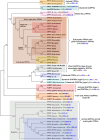New insights into short-chain prenyltransferases: structural features, evolutionary history and potential for selective inhibition
- PMID: 19633972
- PMCID: PMC11115643
- DOI: 10.1007/s00018-009-0100-9
New insights into short-chain prenyltransferases: structural features, evolutionary history and potential for selective inhibition
Abstract
Isoprenoids form an extensive group of natural products involved in a number of important biological processes. Their biosynthesis proceeds through sequential 1'-4 condensations of isopentenyl diphosphate (C5) with an allylic acceptor, the first of which is dimethylallyl diphosphate (C5). The reactions leading to the production of geranyl diphosphate (C10), farnesyl diphosphate (C15) and geranylgeranyl diphosphate (C20), which are the precursors of mono-, sesqui- and diterpenes, respectively, are catalyzed by a group of highly conserved enzymes known as short-chain isoprenyl diphosphate synthases, or prenyltransferases. In recent years, the sequences of many new prenyltransferases have become available, including those of several plant and animal geranyl diphosphate synthases, revealing novel mechanisms of product chain-length selectivity and an intricate evolutionary path from a putative common ancestor. Finally, there is considerable interest in designing inhibitors specific to short-chain prenyltransferases, for the purpose of developing new drugs or pesticides that target the isoprenoid biosynthetic pathway.
Figures


Similar articles
-
Metal ions control product specificity of isoprenyl diphosphate synthases in the insect terpenoid pathway.Proc Natl Acad Sci U S A. 2013 Mar 12;110(11):4194-9. doi: 10.1073/pnas.1221489110. Epub 2013 Feb 25. Proc Natl Acad Sci U S A. 2013. PMID: 23440195 Free PMC article.
-
Determination of residues responsible for substrate and product specificity of Solanum habrochaites short-chain cis-prenyltransferases.Plant Physiol. 2014 Jan;164(1):80-91. doi: 10.1104/pp.113.230466. Epub 2013 Nov 19. Plant Physiol. 2014. PMID: 24254315 Free PMC article.
-
Interaction with the small subunit of geranyl diphosphate synthase modifies the chain length specificity of geranylgeranyl diphosphate synthase to produce geranyl diphosphate.J Biol Chem. 2002 Feb 1;277(5):3141-9. doi: 10.1074/jbc.M105900200. Epub 2001 Dec 3. J Biol Chem. 2002. PMID: 11733504
-
Assembly-Line Catalysis in Bifunctional Terpene Synthases.Acc Chem Res. 2021 Oct 19;54(20):3780-3791. doi: 10.1021/acs.accounts.1c00296. Epub 2021 Jul 13. Acc Chem Res. 2021. PMID: 34254507 Free PMC article. Review.
-
Chain elongation in the isoprenoid biosynthetic pathway.Curr Opin Chem Biol. 1997 Dec;1(4):570-8. doi: 10.1016/s1367-5931(97)80054-3. Curr Opin Chem Biol. 1997. PMID: 9667899 Review.
Cited by
-
The Property of a Key Amino Acid Determines the Function of Farnesyl Pyrophosphate Synthase in Sporobolomyces pararoseus NGR.Curr Issues Mol Biol. 2024 Apr 3;46(4):3108-3121. doi: 10.3390/cimb46040195. Curr Issues Mol Biol. 2024. PMID: 38666925 Free PMC article.
-
Host plants and obligate endosymbionts are not the sources for biosynthesis of the aphid alarm pheromone.Sci Rep. 2017 Jul 20;7(1):6041. doi: 10.1038/s41598-017-06465-9. Sci Rep. 2017. PMID: 28729739 Free PMC article.
-
Expression of the mevalonate pathway enzymes in the Lutzomyia longipalpis (Diptera: Psychodidae) sex pheromone gland demonstrated by an integrated proteomic approach.J Proteomics. 2014 Jan 16;96:117-32. doi: 10.1016/j.jprot.2013.10.028. Epub 2013 Nov 1. J Proteomics. 2014. PMID: 24185139 Free PMC article.
-
Metal ions control product specificity of isoprenyl diphosphate synthases in the insect terpenoid pathway.Proc Natl Acad Sci U S A. 2013 Mar 12;110(11):4194-9. doi: 10.1073/pnas.1221489110. Epub 2013 Feb 25. Proc Natl Acad Sci U S A. 2013. PMID: 23440195 Free PMC article.
-
Dynamic Control of ERG20 and ERG9 Expression for Improved Casbene Production in Saccharomyces cerevisiae.Front Bioeng Biotechnol. 2018 Nov 1;6:160. doi: 10.3389/fbioe.2018.00160. eCollection 2018. Front Bioeng Biotechnol. 2018. PMID: 30443546 Free PMC article.
References
-
- Ogura K, Toyama T, Sagami H. Polyprenyl diphopshate synthases. In: Bittman R, editor. Subcellular biochemistry. New York: Plenum; 1997. pp. 57–87. - PubMed
-
- Ko TP, Chen YK, Robinson H, Tsai PC, Gao YG, Chen APC, Wang AHJ, Liang PH. Mechanism of product chain length determination and the role of a flexible loop in Escherichia coli undecaprenyl-pyrophosphate synthase catalysis. J Biol Chem. 2001;276:47474–47482. doi: 10.1074/jbc.M106747200. - DOI - PubMed
-
- Croteau R, Purkett PT. Geranyl pyrophosphate synthase: characterization of the enzyme and evidence that this chain-length specific prenyltransferase is associated with monoterpene biosynthesis in sage (Salvia officinalis) Arch Biochem Biophys. 1989;271:524–535. doi: 10.1016/0003-9861(89)90304-4. - DOI - PubMed
Publication types
MeSH terms
Substances
LinkOut - more resources
Full Text Sources
Other Literature Sources
Miscellaneous

